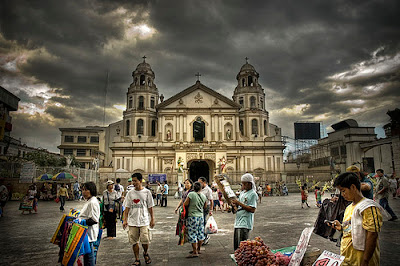Quiapo Church
image credits: travelphilippinesnow.com
Plaza Miranda
image credits: skyscrapercity.com
The Quiapo Church, Lacson Underpass, and Carriedo Street during Sundays are usually described as a cacophony, a hodge-podge, and a fascinating barrage to the sensories. It's not surprising that hawkers, consumers, and passers-by collide on this day every week. The Church attracts a multitude of followers, devotees if you must, plus a random hundred or two who have other plans aside from attending the Catholic service that day. I was one of the latter. I was on the hunt for any plausible medicine, eccentricity notwithstanding, that can cure uterine leiomyoma.
Roughly 50% of the entire business that takes place outside Quiapo Church involves candle-selling. My first stop on this walkabout was Ate Mayeng's cart of wishing candles in Plaza Miranda. One can describe Ate Mayeng's wares as a rainbow of colors. For 20 pesos, you get 7 candlesticks of different hues. Each candle possesses the power to affect a certain aspect of your life, to wit:
BLUE - to attain peace of mind
YELLOW - to protect your general being
WHITE - to symbolize purity and to grant your birthday wish
RED - to wish for good health
VIOLET - to achieve spirituality
GREEN - to make money
BLACK - to clear your conscience
PEACH - to ace the exams
PINK - to bless your loved-ones
You have to say this prayer before you light the wicks of the entire lump: "Diyos Ama sa langit, Liwanag ni Jesus, ipagsanggalan mo kami sa kadiliman at sa aking mga kasalanan; tanggapin mo po ang liwanag ng Kandila ng katotohanan; humihingi ng Banal na Grasya, sumasamo sa iyong Mahal na Poong Nazareno, Amen." You get to say your personal wishes three times at the end of the prayer.
Quiapo candles
image credits: tourism-philippines.com
Around the immediate vicinity of Plaza Miranda were stalls of fortune tellers. I walked past them, for I really fear that I might be haunted if the clairvoyants use the dark elements. Aside from the paranormal, some Quiapo tenants offer reflexology and aromatherapy sessions for their clients.
On some mobile carts, there were strange-looking wax figures that resemble odd faces and human bodies. I got freaked out, and a bit curious. When I politely asked the peddler about the purpose of those wax figures, she wanted me to buy some of her candles first, then she'll tell. I declined. It's probably for voodoo.
This walkabout was just starting, but it was already getting bizarre. Truth be told, I did this walkabout simply for a school requirement for the module on Philippine Health Systems. Just in time, I noticed a familiar face and stealthily stalked behind him. As it turns out, it was Lowie, and he was there for the same purpose as mine.
Just before Plaza Miranda meets Carriedo, I noticed a lady in white uniform, presumably a trained healthcare giver, holding a cuff of a sphygmomanometer that was latched unto an old man eager for his blood pressure read. On the table was a stack of several harmless-looking cartons of pharmaceuticals: multivitamins, paracetamol, and mifepristone; was I easily fooled. I later learned that this mifepristone, along with misoprostol, was the abortifacient that our professors wanted us to hunt down in Quiapo Medical Center.
We found beautiful stones, talismans, empty rifle bullets, burnt charcoal, magnetic decoration, even tawas chunks. There were more than five different types of soap bars: oatmeal, papaya, glutathione, tawas and whatnot. These were indicated for many skin disorders and the culture of vanity shared by many Filipinos.
I was excited to see buntot pagi (sting ray tail) being sold in many stalls; apparently aswangs still lurk in this city. Another vendor offered us malabituin, a sort of coconut-like husk shaped like a four-point star, which is indicated for goiter. It should be hung on the neck juxtaposed to the growing thyroid lump of the patient, she said.
Hinting at her warm receptiveness to our various queries, I asked her about my mother's growing nodule inside the uterus and how we can stop its growth. She advised of boiling guyabano leaves and drinking that herbal extract every day.
We continued our walkabout to another stall and asked for a cure to the leiomyoma. I was shocked when the lady vendor asked us about having problems with menstruation. Has she assumed that we were looking for abortifacients? Have we blown our cover? How does she know? Without any cue, she immediately handed to us this big white opaque packet, which read as a preparation for the treatment of various disorders of the female reproductive system, notably for the return of menses and the cure for ovarian cysts.
I politely refused buying the product, and insisted that I was looking for a remedy for a growing lump inside my mom's uterus. She then presented us a small sachet of milagrosa, containing dried herbs with spicules. I imagined it was potpourri.
Further along, we encountered a young lady selling different types of ointment. She warned us that the red eucalyptus ointment was a strong preparation, indicated for the relief of muscle pain. The white sampaguita ointment, on the other hand, was a milder version used for the treatment of hair diseases like dandruff, lice, etc.
In the end, we felt overwhelmed by the sheer volume of information from this walkabout. Interestingly, we took a short detour to Plaza Santa Cruz and Chinatown just a few meters away, where Lowie bought a red-gold windchime from a majestic-looking Chinese stall. Nearby, I see a drugstore selling traditional Chinese medicine, and my eyes instantly searched for Pei Pa Koa (loquat syrup), a cough suppressant that my parents buy for me when I have colds & flu. Instantly, I felt closer to home, and briefly thought that I was more Chinese than Filipino.
Amusingly, I have nary a trace of Chinese blood.





No comments:
Post a Comment